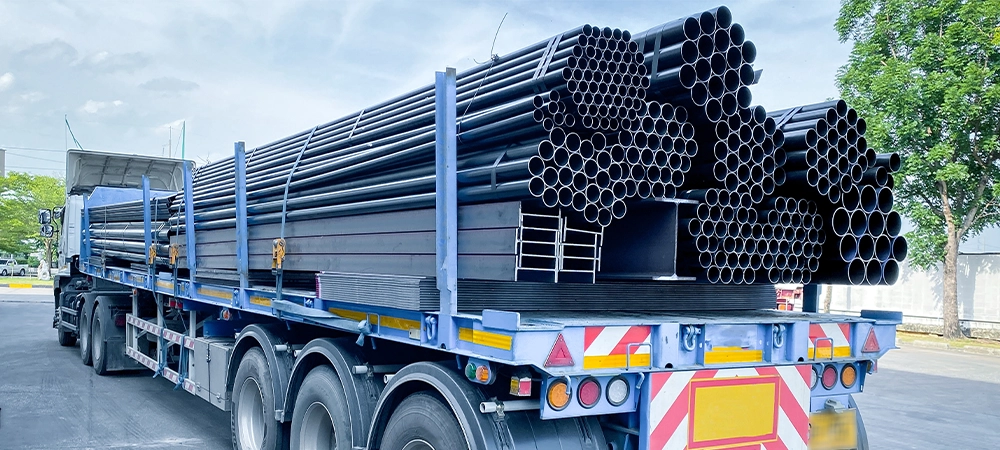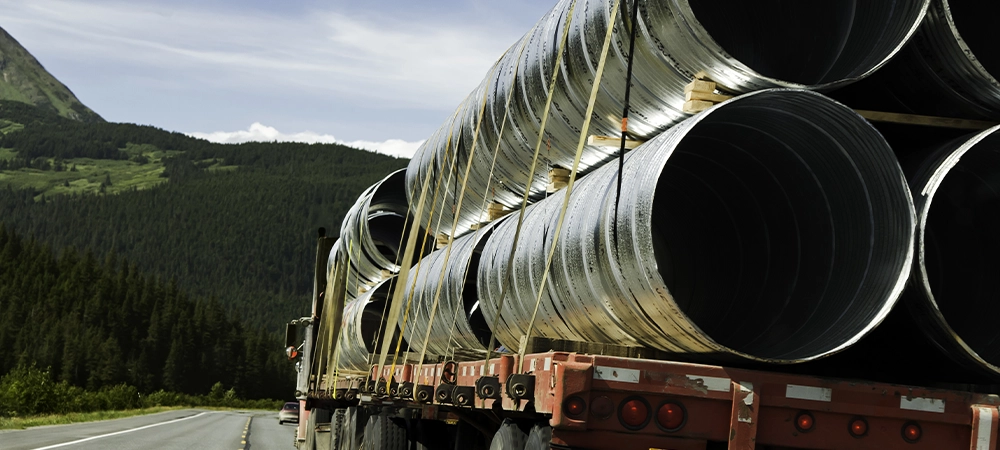
Securing a Pipe on a Flatbed: A Comprehensive Guide
Securing cargo on a flatbed trailer demands meticulous attention and adherence to safety standards to prevent accidents during transportation.
Transporting pipes is a routine necessity for businesses and contractors in industries like construction and plumbing. These cylindrical items, with their propensity for rolling and shifting, pose unique challenges for securement.
The best way to secure pipes on a flatbed is to have the right equipment, such as dunnage, edge protectors, and tarps. You’ll also want to ensure you arrange the pipes carefully on the flatbed in a single layer and use the dunnage to prevent them from rolling off.
This guide delves into the essential steps and best practices for securing pipes on a flatbed trailer, ensuring they reach their destination safely.
The Right Equipment for Securing Pipes on a Flatbed
Securing pipes on a flatbed trailer isn’t just about ensuring they arrive undamaged; it’s also a critical safety issue that affects everyone on the road. Adhering to FMCSA regulations and guidelines for cargo securement is not only a legal requirement but a moral one.
Securing pipes on a flatbed begins with having the right equipment. Here are the essential tools and materials you will need:
- Ratchet Straps: Ratchet straps are among the most versatile and commonly used tools for securing cargo on a flatbed. They are made of durable webbing and feature a ratcheting mechanism that allows for easy tightening and securement of the load.
- Winch Straps: Winch straps are similar to ratchet straps but are designed for use with winches mounted on the flatbed. They are threaded through the winch and tightened using its mechanism, providing a secure and adjustable hold on the cargo.
- Edge Protectors: Edge protectors, also known as corner protectors, prevent straps from damaging the edges of the cargo, particularly when securing sharp or heavy items like pipes. They are typically made of durable materials such as rubber or plastic and help evenly distribute the straps’ pressure.
- Dunnage: Dunnage refers to materials such as lumber, blocks, or pads used to fill empty spaces between cargo or provide a stable base for securing the load. Dunnage helps prevent movement and shifting of the cargo during transit, reducing the risk of damage.
- Pipe Brackets or Saddles: Pipe brackets or saddles are specially designed fixtures cradling and supporting pipes during transportation. You mount them on the flatbed and provide a secure resting place for the pipes, preventing them from rolling or shifting.
- Load Binders: Load binders, also known as chain or lever binders, are used to secure heavy or irregularly shaped cargo on flatbed trucks. They use mechanical leverage to tighten chains or straps around the cargo, ensuring a tight and secure hold.
- Rubber Tarp Straps: Rubber tarp straps secure tarpaulins or covers over cargo to protect it from the elements during transit. They are elastic and stretchable, allowing for a tight and secure fit over the load.
- Chains and Binders: Chains and binders can be used instead of straps to secure extremely heavy or oversized pipes. Chains provide added strength and durability, while binders allow for precise tensioning and securement of the load.
- Anti-Slip Mats or Pads: Place the anti-slip mats or pads between the cargo and the flatbed surface to prevent movement and sliding during transit. They provide additional friction and stability, particularly for smooth or slippery loads.
- Safety Flags and Lights: Use safety flags and lights to mark oversized or protruding loads for increased visibility and safety, especially when transporting pipes that extend beyond the dimensions of the flatbed.
Related Article: Secure Shipments: Top 10 Must-Have Ratchet Straps for Shipping Success
Flatbed Securing Tips: How to Secure Pipes Safely
It’s crucial to understand the risks involved in transporting such cargo. Due to their shape and size, pipes can easily roll off the flatbed if not secured properly, leading to road hazards or accidents. Also, improper securement can damage the pipes, the trailer, and other road users.
Here’s how to secure a pipe on a flatbed
Prepare the Flatbed
Start by inspecting the flatbed trailer for damages that can compromise the safety of the load. Clean the deck of debris or objects that could damage the pipes or interfere with securement. Also, lay friction mats on the flatbed where the pipes will rest.
Arrange the Pipes Carefully
Load the pipes onto the flatbed, arranging them side by side in a single layer if possible. Use dunnage to create a cradle for the pipes, preventing them from rolling. For larger pipes that need to be stacked, place additional dunnage between layers and around the perimeter of each layer to maintain stability.
Apply Straps or Chains
Once you arrange the pipes, it’s time to secure them to the flatbed. If using ratchet straps, thread the strap through it and pull it tight over the pipes, ensuring the tension is even across the load.
If using chains, wrap them around the pipes and secure them with a chain binder. Place edge protectors under the straps or chains to prevent damage to the pipes and the securement devices.
Check Tension and Securement Points
After applying the initial tension, check each strap or chain to ensure it’s secured tightly and that the flatbed’s securement points can handle the load. The Federal Motor Carrier Safety Administration (FMCSA) recommends a minimum of one tie-down for every 10 feet of cargo, but this may vary depending on the weight and size of the load.
Final Inspection and Adjustments
Conduct a final load inspection, check for loose straps or chains, and ensure all dunnage is secure. Make any necessary adjustments to ensure the pipes are immovable and the securement equipment is not at risk of loosening during transport.
Regular Checks During Transit
It’s essential to perform regular checks on the load during transit, especially after the first few miles and following any significant changes in speed or direction. This allows you to catch and rectify any issues before they become serious hazards.
Related Article: The Role of Corner Protectors in Reducing Shipping Damages
Secure Pipes on Your Flatbed with Ease
To safely secure pipes on a flatbed requires careful planning, the right equipment, and an understanding of securement principles. By following these guidelines, you can ensure your loads are safe, secure, and compliant with regulations.
At Toronto Trailers, we understand the importance of secure cargo transport. From winch and ratchet straps to edge protectors, we offer a range of equipment and accessories designed to meet your transportation needs.
Remember, a securely fastened load is safe, and securing your cargo properly is an investment in road safety. Call us today at 416-477-5488.





